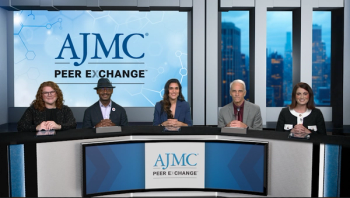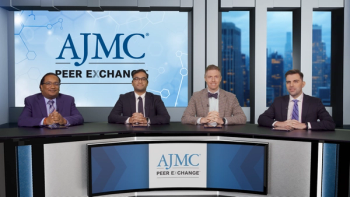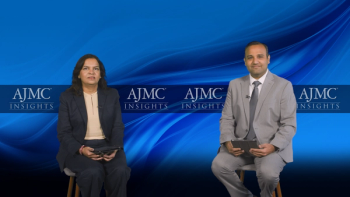
Understanding the Transition From RRMS to SPMS
Thomas P. Leist, MD, PhD: I do think that there needs to be an underlying biological meaningfulness of this differentiation. For example, look at the terms that can be progressive; in fact, Pat Coyle already introduced the terms. It’s an individual who had relapsing-remitting disease but now has some inflammatory events, relapse, or new lesions on the brain MRI [magnetic resonance imaging], but who also has progression of disability in between. If you now have a patient who is successfully treated with an immune modulator, you may also have a patient who has a little of progression that breaks through. Is that person having truly secondary progressive disease, or is this just a residual of the prior injuries that you have in this individual?
Patricia K. Coyle, MD, FAAN, FANA: I think this gets into the issue that it can be difficult for clinicians to tell when a relapsing patient has truly transitioned to secondary progressive disease. I would mention, I think most people would support that progressive MS [multiple sclerosis] is neurodegenerative MS; that there are some biological underpinnings to slowly worsening MS, the neurodegenerative phase of the disease.
Peter L. Salgo, MD: I wanted to go there right now. I’m glad you took us there. The most common form of MS is what, with all these acronyms?
Patricia K. Coyle, MD, FAAN, FANA: Relapsing-remitting.
Peter L. Salgo, MD: The one you don’t like. The name you don’t like.
Patricia K. Coyle, MD, FAAN, FANA: Right, 85% to 90% starts out as relapsing MS.
Peter L. Salgo, MD: And then a percentage of those patients with that RRMS [relapsing-remitting multiple sclerosis] transition to SPMS [secondary-progressive multiple sclerosis].
Patricia K. Coyle, MD, FAAN, FANA: Yes. Yes.
Peter L. Salgo, MD: But what is that? Why do they do that? What percentage do that? And what does that imply for their quality of life?
Patricia K. Coyle, MD, FAAN, FANA: The percentage appears to be falling in the modern era with treatment. There is an increasing number of studies that are addressing treatment versus no treatment, early treatment versus late treatment. Stronger treatment significantly decreases the proportion transitioning to secondary-progressive MS. Whether they’re delaying it or preventing it, we don’t know. We need to follow along enough.
Peter L. Salgo, MD: But if you delay it long enough, it’s the same as preventing it.
Patricia K. Coyle, MD, FAAN, FANA: Absolutely right. But the interesting thing is, progressive MS is age-linked, mid-40s, about 45 to 50. There’s something about that midlife age in which you have the association of gradual worsening. To me, without documentation, the neurodegenerative damage of MS is most likely silent for a number of years. But at some point, you have enough neurodegenerative injury that you see the clinical expression of slow worsening.
Peter L. Salgo, MD: It crosses the threshold at midlife. That would be suggestive to me. Don’t you think, Tom?
Thomas P. Leist, MD, PhD: Yes. That will be then a matter of duration of the disease in many of these individuals for whom an unchecked disease will have created so much injury.
Peter L. Salgo, MD: That’s right.
Thomas P. Leist, MD, PhD: But now there is a progression because of the inability of the brain to compensate.
Patricia K. Coyle, MD, FAAN, FANA: Right. This is also why early treatment may be key in controlling comorbid conditions and having a wellness healthy lifestyle.
Peter L. Salgo, MD: Look, we can put this on the table. I have yet to see a disease that wouldn’t be made better by controlling cholesterol, blood pressure, blood sugar. So those are just generic. But generic that is important, right?
Patricia K. Coyle, MD, FAAN, FANA: Right.
Maria Lopes, MD, MS: There are also a plethora of data that show that if you can maintain their EDSS [Kurtzke Expanded Disability Status Scale] to less than or equal to 3, versus greater than 3, there’s a huge impact on not only cost but symptoms, comorbidities, and all the things we’re trying to prevent downstream. But I find it fascinating as we get into the different forms of MS. Can we get agreement—guidelines, consensus—in terms of what is the profile of somebody with relapsing versus secondary progressive versus primary progressive, these different disease states, in the absence of a true biomarker?
Thomas P. Leist, MD, PhD: I think the FDA has tried to build a buffer between the purely progressive forms of multiple sclerosis and the relapsing forms of multiple sclerosis. It has called out specifically the active secondary-progressive presence of either new MRI lesions or attacks in an individual, versus the patients who have what I sometimes call the dwindler—individuals who have just progression.
I just will caution that this very often means that the patient at that time is not on treatment, or it becomes more difficult to evaluate this if the patient is on ongoing treatment, because what would this patient be if the agent were not modifying the disease?
Patricia K. Coyle, MD, FAAN, FANA: I was actually very surprised that the FDA went there, to be honest. I was surprised that they said active SPMS [secondary-progressive multiple sclerosis] is a relapsing form of MS. Clearly, we accept that.
Peter L. Salgo, MD: Is SPMS different from RMS?
Patricia K. Coyle, MD, FAAN, FANA: Well, SPMS started out as relapsing MS, and there’s a transition period. Some people have suggested it’s about 5 years. Relapses in the MRI marker that contrast enhancing lesions are related to young age and early MS disease duration. So clinical attacks and contrast enhancing lesions become less and less common the older you get and the longer you have MS.
Peter L. Salgo, MD: What percentage of patients, all comers, are diagnosed with SPMS?
Patricia K. Coyle, MD, FAAN, FANA: That’s a shifting field.
Peter L. Salgo, MD: How did I know you were going to say that?
Patricia K. Coyle, MD, FAAN, FANA: In many large centers you might have upward of 30% hitting secondary-progressive MS. But over time in the treatment era, the SPMS group seems to be shrinking a bit. Would you agree, Tom?
Thomas P. Leist, MD, PhD: I agree with that. Many of the data that we have are of long-term cohorts that include patients who were never on treatment, only partially on treatment. I think it’s very important. And because this is a conversation also around payer points, we have patient groups that are highly vulnerable to be on-off, on-off, on-off treatments, particularly Medicaid patients. Keep in mind that in the Medicaid population, only about 20% of patients are on medication continuously for 5 years.
Newsletter
Stay ahead of policy, cost, and value—subscribe to AJMC for expert insights at the intersection of clinical care and health economics.






































